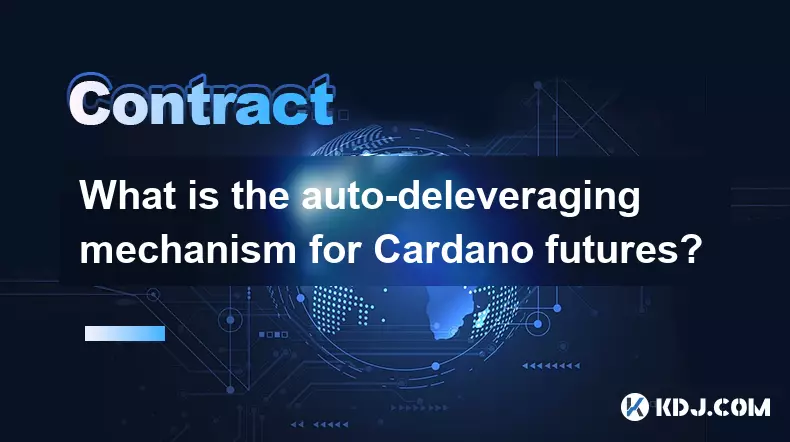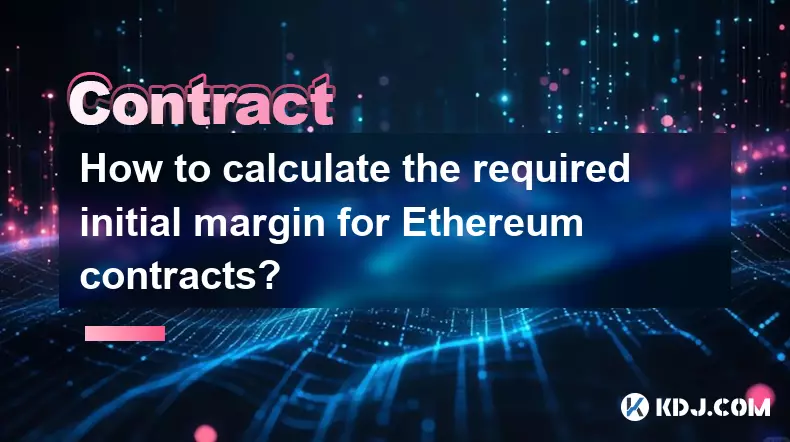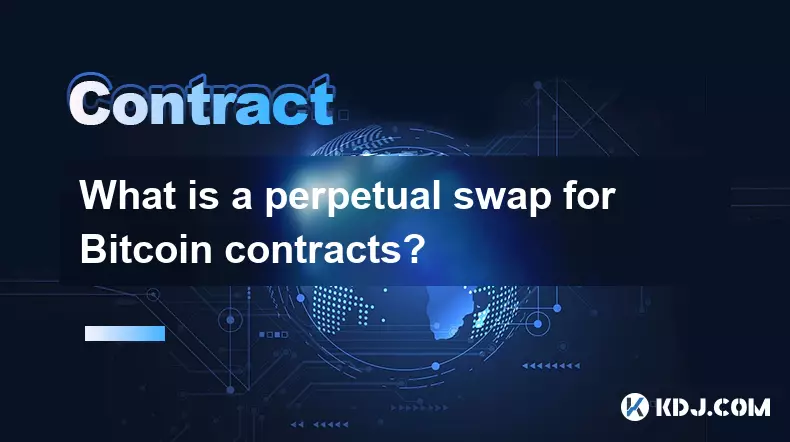-
 bitcoin
bitcoin $120167.907534 USD
1.27% -
 ethereum
ethereum $4468.611945 USD
2.53% -
 xrp
xrp $3.013607 USD
1.80% -
 tether
tether $1.000549 USD
-0.01% -
 bnb
bnb $1092.592149 USD
6.28% -
 solana
solana $231.391244 USD
4.59% -
 usd-coin
usd-coin $0.999699 USD
-0.04% -
 dogecoin
dogecoin $0.259020 USD
4.30% -
 tron
tron $0.342747 USD
0.34% -
 cardano
cardano $0.860977 USD
1.07% -
 hyperliquid
hyperliquid $50.155412 USD
5.34% -
 chainlink
chainlink $22.637678 USD
0.46% -
 ethena-usde
ethena-usde $1.000528 USD
-0.07% -
 avalanche
avalanche $30.613779 USD
-0.07% -
 stellar
stellar $0.403905 USD
0.94%
What is the auto-deleveraging mechanism for Cardano futures?
Auto-deleveraging in Cardano futures protects exchanges by closing profitable opposite-side positions when liquidations can't be filled, especially during high volatility.
Sep 29, 2025 at 02:18 pm

Understanding Auto-Deleveraging in Cardano Futures
1. Auto-deleveraging is a risk management mechanism used by certain cryptocurrency derivatives exchanges when handling perpetual futures contracts, including those tied to Cardano (ADA). When a trader's position is liquidated due to insufficient margin, the exchange must close that position. In extreme market conditions or during periods of low liquidity, the platform may not be able to close the position via the order book at a reasonable price. To cover the shortfall and prevent losses being absorbed by the insurance fund or other traders, the exchange resorts to auto-deleveraging.
2. This process involves forcibly closing offsetting positions from profitable traders on the opposite side of the market. For example, if a long position in ADA/USDT perpetuals is being liquidated, the system will target short positions that are currently in profit. The goal is to transfer part of the liquidated position’s risk to these profitable counterparties, effectively reducing their positions to cover the loss gap.
3. The selection of which opposing positions get deleveraged typically follows a ranking based on leverage used and profitability. Traders who employ very high leverage and are significantly in profit are more likely to be targeted. This ensures that the burden falls on those whose trading behavior contributed most directly to systemic risk exposure.
4. Auto-deleveraging does not occur frequently but becomes more probable during sharp price movements where multiple liquidations happen simultaneously. Because Cardano can experience volatility—especially around protocol upgrades or major ecosystem announcements—the risk of cascading liquidations increases, making this mechanism an essential backstop for exchange solvency.
5. It's important to note that not all exchanges implement auto-deleveraging. Some platforms prefer relying solely on insurance funds or socialized loss models. However, leading derivatives exchanges like BitMEX, Bybit, and OKX have historically used auto-deleveraging as part of their risk engine design, especially for assets with intermittent liquidity such as altcoins including Cardano.
How Auto-Deleveraging Impacts Traders
1. Traders holding profitable short positions in Cardano futures may suddenly find their positions partially or fully closed without warning during volatile downturns. This happens even if their margin levels are healthy, simply because they are on the profitable side of the market when a deleveraging event is triggered.
2. The impact is most severe for those using maximum allowable leverage. High-leverage positions amplify both gains and the likelihood of being selected during auto-deleveraging rounds. A trader might see their entire profit erased in moments due to no fault of their own strategy.
3. There is also a psychological effect: knowing that profits can be forcibly taken away during crises may discourage aggressive positioning, especially near key support or resistance zones. This influences market dynamics by reducing available liquidity precisely when it's needed most.
4. Transparency varies between platforms. Some provide real-time indicators showing the probability of auto-deleveraging, while others offer only post-event reports. Lack of visibility makes it difficult for traders to assess personal risk exposure accurately.
5. Frequent auto-deleveraging events can erode trust in a platform’s risk model. If traders perceive the system as unfair or unpredictable, they may migrate to exchanges with alternative mechanisms such as guaranteed stop-losses or deeper insurance funds.
Risk Mitigation Strategies for Cardano Futures Traders
1. Avoiding maximum leverage settings reduces the chance of being targeted during auto-deleveraging. Using conservative leverage—even during strong trends—helps maintain buffer against unexpected position closures.
2. Monitoring funding rates and open interest can signal increasing systemic risk. Elevated long-to-short ratios combined with rising funding costs often precede large-scale liquidation clusters that could trigger deleveraging.
3. Diversifying across exchanges with different risk models allows traders to balance exposure. Platforms that use 'socialized loss' or robust insurance funds may offer more predictability, though they come with other trade-offs.
4. Setting hard stop-loss orders outside the typical volatility range helps exit positions before reaching dangerous margin thresholds. While stops aren't foolproof during flash crashes, they reduce dependency on exchange-level safety nets.
5. Staying informed about upcoming Cardano network developments—such as Vasil hard forks or Hydra scaling rollouts—enables better anticipation of price swings. Proactive position adjustment ahead of known catalysts lowers vulnerability to sudden market moves.
Frequently Asked Questions
What triggers auto-deleveraging in Cardano futures?Auto-deleveraging is triggered when a leveraged long or short position is liquidated and the prevailing market depth is insufficient to close it at a fair price. If the bankruptcy price of the liquidated position exceeds the available counterparty liquidity, the exchange initiates auto-deleveraging to forcibly close profitable opposite-side positions.
Can I avoid being auto-deleveraged?While complete avoidance isn't possible on platforms that use this mechanism, risks can be minimized. Use lower leverage, avoid holding extremely profitable positions during high-volatility periods, and consider exiting manually when signs of market stress appear. Choosing exchanges with transparent risk frameworks also improves preparedness.
Does auto-deleveraging affect spot traders?No, auto-deleveraging applies exclusively to derivative instruments such as perpetual and quarterly futures contracts. Spot market participants who hold ADA directly in wallets or exchange balances are not exposed to this mechanism.
Are there alternatives to auto-deleveraging?Yes. Some exchanges use insurance funds to absorb losses from undercollateralized positions. Others employ socialized loss models where all traders share the cost proportionally. These approaches eliminate forced closures but introduce different forms of systemic risk and fairness concerns.
Disclaimer:info@kdj.com
The information provided is not trading advice. kdj.com does not assume any responsibility for any investments made based on the information provided in this article. Cryptocurrencies are highly volatile and it is highly recommended that you invest with caution after thorough research!
If you believe that the content used on this website infringes your copyright, please contact us immediately (info@kdj.com) and we will delete it promptly.
- BlockDAG, DOGE, HYPE Sponsorship: Crypto Trends Shaping 2025
- 2025-10-01 00:25:13
- Deutsche Börse and Circle: A StableCoin Adoption Powerhouse in Europe
- 2025-10-01 00:25:13
- BlockDAG's Presale Buzz: Is It the Crypto to Watch in October 2025?
- 2025-10-01 00:30:13
- Bitcoin, Crypto, and IQ: When Genius Meets Digital Gold?
- 2025-10-01 00:30:13
- Stablecoins, American Innovation, and Wallet Tokens: The Next Frontier
- 2025-10-01 00:35:12
- NBU, Coins, and Crypto in Ukraine: A New Yorker's Take
- 2025-10-01 00:45:14
Related knowledge

What is the difference between futures and perpetual contracts for Bitcoin?
Oct 02,2025 at 11:54pm
Understanding Bitcoin Futures Contracts1. Bitcoin futures are derivative instruments that allow traders to speculate on the future price of Bitcoin at...

What are the common mistakes to avoid with Bitcoincoin contracts?
Oct 03,2025 at 08:54am
Emerging Trends in the Cryptocurrency Market1. Decentralized finance (DeFi) platforms continue to expand their influence across the blockchain ecosyst...

What is the maintenance margin for Bitcoin contracts?
Oct 02,2025 at 01:36am
Decentralized Exchanges Gain Momentum in 20241. Decentralized exchanges (DEXs) have seen a significant rise in trading volume, surpassing centralized ...

How to calculate the required initial margin for Ethereum contracts?
Oct 01,2025 at 06:01am
Understanding Initial Margin in Ethereum Futures1. The initial margin for Ethereum futures contracts represents the minimum amount of capital a trader...

What is a perpetual swap for Bitcoin contracts?
Oct 01,2025 at 08:18am
Understanding Perpetual Swaps in Bitcoin Trading1. A perpetual swap is a type of derivative contract that allows traders to speculate on the price of ...

What is the best platform for trading SOL contracts?
Oct 01,2025 at 06:36am
Understanding the Role of Decentralized Exchanges in Modern Crypto Trading1. Decentralized exchanges (DEXs) have reshaped how traders interact with di...

What is the difference between futures and perpetual contracts for Bitcoin?
Oct 02,2025 at 11:54pm
Understanding Bitcoin Futures Contracts1. Bitcoin futures are derivative instruments that allow traders to speculate on the future price of Bitcoin at...

What are the common mistakes to avoid with Bitcoincoin contracts?
Oct 03,2025 at 08:54am
Emerging Trends in the Cryptocurrency Market1. Decentralized finance (DeFi) platforms continue to expand their influence across the blockchain ecosyst...

What is the maintenance margin for Bitcoin contracts?
Oct 02,2025 at 01:36am
Decentralized Exchanges Gain Momentum in 20241. Decentralized exchanges (DEXs) have seen a significant rise in trading volume, surpassing centralized ...

How to calculate the required initial margin for Ethereum contracts?
Oct 01,2025 at 06:01am
Understanding Initial Margin in Ethereum Futures1. The initial margin for Ethereum futures contracts represents the minimum amount of capital a trader...

What is a perpetual swap for Bitcoin contracts?
Oct 01,2025 at 08:18am
Understanding Perpetual Swaps in Bitcoin Trading1. A perpetual swap is a type of derivative contract that allows traders to speculate on the price of ...

What is the best platform for trading SOL contracts?
Oct 01,2025 at 06:36am
Understanding the Role of Decentralized Exchanges in Modern Crypto Trading1. Decentralized exchanges (DEXs) have reshaped how traders interact with di...
See all articles










































































